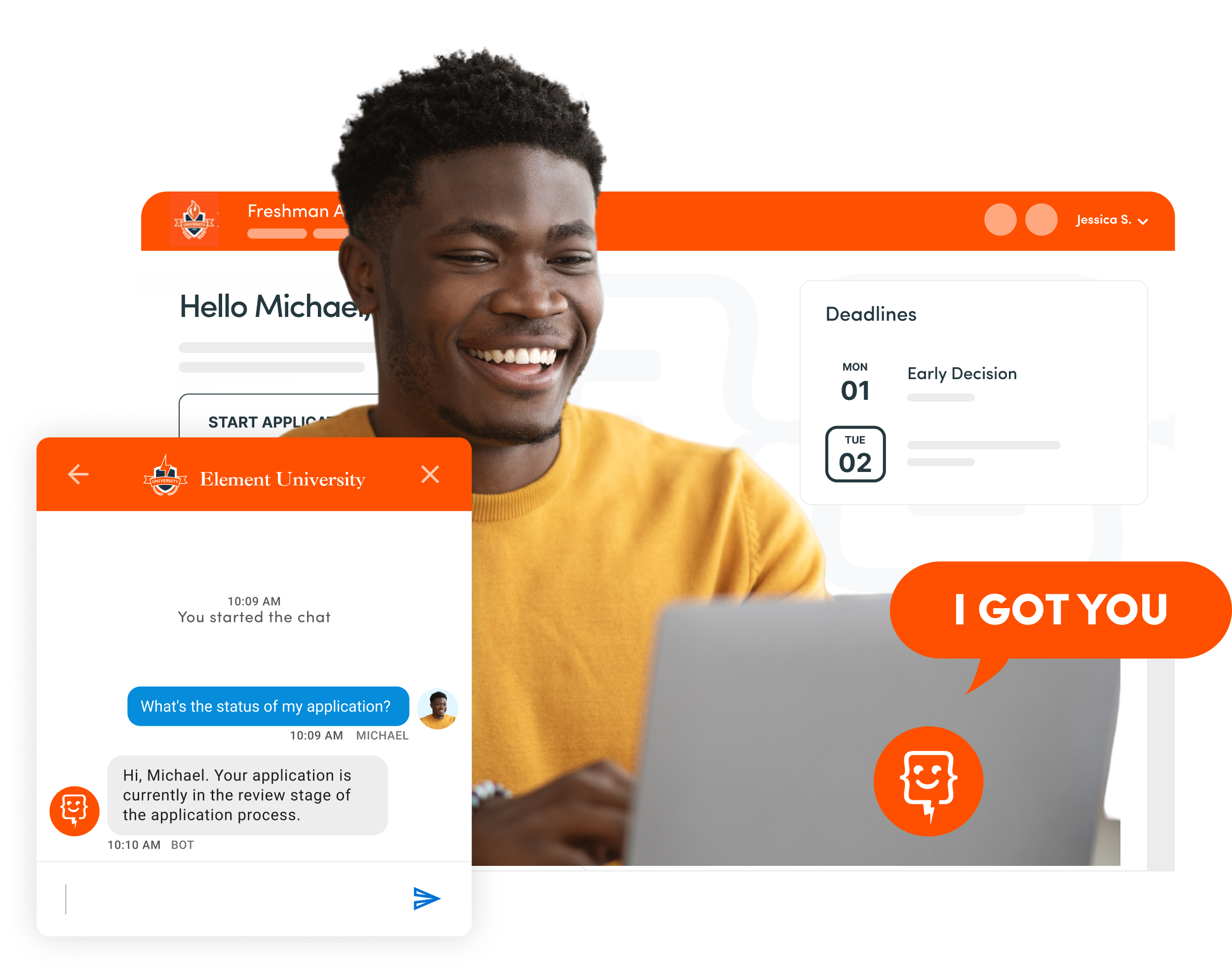Admissions Strategies for Community College Students: How to Attract Students
by Rita Winthrop · Updated Sep 13, 2024
As different higher education institutions cater to unique groups of students, community college is no exception. Community colleges (including over 5,000 schools across the country) serve as a foundational part of the higher education system in the United States and provide unique academic benefits to students who enroll.
But as a number of college administrators and leaders can testify, attracting those students and securing new enrollments is steady work year over year. The process from initial outreach to student enrollment must include tactics related to marketing, recruitment, enrollment, and student engagement. A complete, comprehensive approach is essential if schools hope to find success in enrollment.
In this blog post, we’ll share several practical, real-world admissions strategies for community colleges as a way to boost application numbers and improve enrollment rates.
Current State of Admissions for Community College Students
Like many four-year institutions, community colleges have experienced documented declines in the semesters both during and after the pandemic. These trends have led some industry leaders to worry that community institutions have been facing what the Associated Press (AP) called “a reckoning.”
Yet despite struggling to gain a foothold throughout the pandemic, community colleges have managed to rebound their admissions numbers. According to Inside Higher Ed, modest admissions growth in 2023, particularly the fall semester, is giving many community college leaders a reason to celebrate.
“The latest data from the National Student Clearinghouse Research Center, released in May, suggest community colleges are starting to make a modest comeback from their pandemic enrollment woes. Community college enrollment rose 0.5 percent this spring, a gain of about 22,000 students nationally.”
To encourage more momentum (and to keep enrollment declines steady), community college admissions offices must use the resources they have available to capture the interest of students at precise moments along the student journey.
Practical Strategies to Increase Enrollment Growth
Competition in the higher education realm is steadily rising. Plus, student expectations are changing and evolving with new hybrid course options, career pathways, and technology advancements. As a result, it’s more crucial that colleges and universities leverage data-backed strategies to increase admissions rates and application numbers.
If your community college admissions strategy lacks direction, consider the following strategies as part of your brand growth, marketing outreach, and recruitment initiative.
1. Create and Maintain a Strong Online Presence
With most pre-college applicants conducting the majority of college research online, community colleges need to have a strong online presence. A well-branded digital footprint includes components like:
- The school’s primary website
- Social media pages on popular platforms
- Partnership sites
- Links other outlets (perhaps PR-related opportunities or news stories)
Community college admissions leaders must ensure that the school’s website is up-to-date and user-friendly.
Additionally, it’s helpful to be where your prospective students spend their time. If this means social media (like Instagram or Facebook), turn to those platforms to share student success stories and testimonials, broadcast upcoming campus events, or provide relevant news articles to keep students in-the-know.
2. Offer Personalized Student Support
Community colleges often aim to serve a wide range of students from diverse backgrounds. Two-year schools might also be the first step on a longer academic journey for many high school and even adult learners.
As a result, providing personalized support during the admissions process is key. Assign each new applicant a dedicated advisor or guide who can help navigate the application process, answer questions, and provide social support.
Personalization is one of the major indicators of student success and engagement in higher education. Starting early, even from initial admissions interactions, sets the tone for future relationships between students and staff members.
3. Focus on Transfer Pathways
Although it’s not the story for everyone, many community college attendees hope to transfer to a four-year college or university after earning their two-year associate’s degree. This holds true for adult students as well as traditional aged students.
While most community colleges recognize the value of this progression to private or public colleges, being mindful of the details early makes a difference. During admissions conversations, highlight transfer pathways and options for students who want to pursue other degrees long-term.
Community colleges can also publish transfer guides, host or sponsor fairs with other colleges, and build working relationships with four-year universities. These options ensure that students are as prepared as possible, and that they transition and transfer credits without stress.
4. Engage in Community Outreach
Community outreach can help schools attract prospective students and foster mutually beneficial relationships with the local community.
One of the most significant ways that schools can accomplish this is by partnering with local high schools whose students might be interested in dual enrollment, summer enrichment courses, or associate’s degrees. Showcase your institution’s offerings and any special benefits that might be unique in your particular region.
For example, if your college serves an area in which students live at home and commute, community college can be a cost-saving option for students who choose to live and learn close to home.
5. Become the Specialist in Your Target Audience
By tailoring marketing efforts to different groups, community college admissions counselors and recruiters can increase the likelihood of success in attracting prospective students. And although community institutions may not have the vast resources or endowment funds of large private schools, the local pool of applicants is much more condensed. This means that community college admissions leaders can reach more students with higher-impact local marketing.
Consider incorporating targeted social media advertisements or highly personalized outreach to high school counselors. These tactics allow you to reach different segments of your audience, seemingly in your own backyard.
To take it one step further, niche down into an academic area that’s especially important to newly-recruited students. For instance, if many nursing students want to advance to higher medical degrees, promote the benefits of a two-year program to save time and money.

Get A Demo of Element451
Students explore and pick where they’ll earn a degree in completely new ways. Welcome to the new world of enrollment, powered by Element451. We've been waiting for you.
Show Me More
Potential Enrollment Challenges for Community College Students
Implementing the right (and most effective) admissions strategies is only one aspect for rebounding enrollment numbers. On the other hand, it’s powerful to address the roadblocks that high school students and others face prior to enrollment. These worries often keep students from making admissions decisions, forcing them to pause their next educational move or put off their goals altogether.
When an admissions team can relate to these very real student concerns—and address them with practical, helpful resources—students may be more likely to enroll.
Financial Barriers
Financial pressures and stressors are extremely common barriers to community college admission.
Although community colleges have relatively low tuition fees compared to other universities, some students and families still have difficulty handling the cost of attendance. For other community college prospects who have been out of school for some time, getting re-educated on different loans, payment plans, and financial incentives might take some time.
To help students overcome financial obstacles, community colleges must prioritize financial aid resources, scholarships, and grants for new students. Other options include waiving application and tech fees or offering diverse payment plans for new students. These offers often alleviate some of the initial stress that students experience when first committing.
Limited Academic Support Resources
Even though community colleges often have more limited resources compared to traditional four-year institutions, students' academic success shouldn’t have to suffer. At the same time, it’s wise to acknowledge that factors like smaller libraries, limited technology or digital tools, and fewer student-ef activities could stand in the way of some enrollments.
Investing in modern technology, online services, and robust social support networks is crucial for long-term campus growth. If community colleges don’t have the means to hire new support staff internally, partnering with local organizations and businesses often creates additional opportunities to meet practical, tangible student needs.
Educational Preparedness
When students encounter gaps in their K-12 schooling (for a number of unique reasons), they may have hesitation about enrolling or applying to community colleges. Even so, two-year programs might be the perfect way to reintegrate into the college atmosphere—or for younger students to experience it safely for the very first time.
Community college administrators must be prepared to help students rise to the occasion, meeting the academic demands of college-level courses. Tutoring services, remediation sessions, and mentoring programs with peers or faculty members can instill student confidence. Additionally, these important resources often help students grow their academic skills, increase confidence, and improve retention through degree attainment.
Personal Obligations
Many potential students who are interested in community college admissions also plan to balance school with work, family, and other commitments.
While the flexibility of a two-year local program seems less demanding right away, it’s often challenging for students to manage their time and priorities in a way that accommodates a new academic program. Unfortunately, balancing too many responsibilities contributes to negative metrics like high absenteeism, low performance, and disengagement.
A helpful approach is to provide flexible course scheduling, including evening sessions and online or hybrid options. As these choices become more standard in larger four-year institutions, applicants might also expect them in the community setting. Academic coaching throughout two-year degrees can also equip students with better time management, study skills, and motivation to finish a degree to completion.
Refuel Your Admissions and Community College Enrollment Rates
Community colleges open new doors to education and training for a wide range of enrolled students, some of whom would not have access to post-secondary education opportunities otherwise. Protecting the future of the community college environment means increasing enrollment by investing in new strategies now to build a solid foundation for the future
Element451 allows community colleges to focus on what they do best—serving a diverse mix of students, community members, and graduates. By personalizing student campaigns through a user-friendly CRM solution, it’s easier to accomplish long-term enrollment goals.
Have more confidence in your enrollment process, starting today. Request a call with our student-focused team to get started.

About Element451
Boost enrollment, improve engagement, and support students with an AI workforce built for higher ed. Element451 makes personalization scalable and success repeatable.
Categories
New Blog Posts

The Definitive Guide
AI in Higher Education
Bridge the gap between the latest tech advancements and your institution's success.
Useful Links
Related Articles

Talk With Us
Element451 is the only AI Workforce Platform for higher education. Our friendly experts are here to help you explore how Element451 can improve outcomes for your school.
Get a Demo








